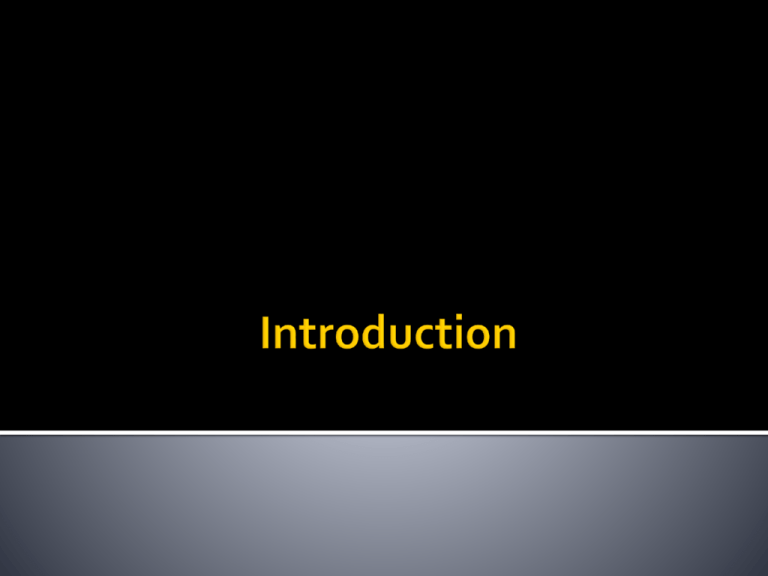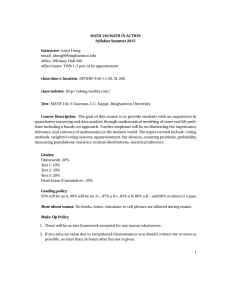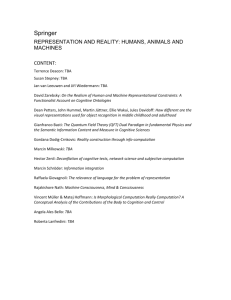
We do experiments in Human-Computer
Interaction because we want to know ...
Is product A better than product B?
What is good and bad about X?
Testing design principles and methods
Etc. etc.
Experimentation in HCI is all about
people
As they will use the products
we develop
But we also – less often - do
experiments without human
involvement
e.g. testing software capabilities
Strictly speaking this is not HCI, but
usually a people-oriented aim
Raw materials for experiments:
People
On their own horribly complex and varied things
to test
... And we usually run tests with groups of people!
Computer interfaces
And software, experiences, designs, art, etc. etc.
People as objects of study:
People are different
Skills, knowledge, expertise
Tiredness, illness, motivation
They think and learn
=> high variability in experimental results
=> hard to obtain significant results
People are also subject to complex effects,
that are hard to control for (measure the
effect of) in experiments
Time of day effects
Tiredness, post-lunch dip, etc.
Transfer effects
Learning and interference
Other problem is that of context:
Experiments can be done in the field or the
laboratory
Each their own strengths and weaknesses
Since we usually involve groups of people, we
have problems with accounting for the effect
of social dynamics
... and group relationships – how do they impact
on what we want to measure?
Finding subjects for experiments is (also) challenging
Nearly always, we have specific criteria that we would like
participants to fulfill
Females, age 30+, driving a powder-blue prius, who likes liqourice
Often we do not have the money to pay people, so
hard to get the right ones
This leads to the problem of most Psychology and HCI
experimental research being done with Psychology and
Computer Science undergraduate students
But how representative are they of the target population we are
interested in?
”Statistics is the
least of your
problems!”
Alan Dix, ”Avoiding Damned Lies”
Statistics is a tool for analyzing data from experiments
and deriving meaning from them
Statistics is a logical process – each type of problem
has one or more statistical methods that can be
employed
If you can identify the problem, you can find the
statistical test to use
Finding help/guides for statistical tests is pretty easy
Statistics is primarily used when we are
looking for ”broad and shallow” results
Using surveys, data logging, large experiments
When using quantitative methods (i.e. Getting
numbers as data)
If we want meaning – in-debt knowledge
about just a few subjects, we use qualitative
methods (numbers as data)
Video logs, not post-task walkthroughs,
anecdotal evidence, etc.
If we want to conclude...
”95% of users had problem X” - we use statistics
”Problem X happens for this reason ...” - we use
qualitative methods
Ideally both! Backup the quantitative data with
When I
qualitative – give meaning to the
grow up, I
want to be
numbers!
a HMW
Statistics are an incredibly powerful tool for
an HCI person (interaction design, usability,
whatever ...)
In this course, focus on applying statistical
methods to analyze experimental data
Some qualitative methods also, but mostly
this is in the course Target Group Analysis
A powder-blue prius
Practical information about the course
Course objectives
Course textbooks
Course plan
Exercise:
Table-top hockey experiment
Center for Computer Games Research
Mostly teaches at DDK-line
Empirical researcher: Science by experimentation
Mostly focused on experiments with humans
(annoying bastards!)
User experience analysis in interactive applications
Games, websites, etc.
Lectures Wednesday 10-12 in room: 4A22
Exercises Wednesdays 13-15 in room: 4A58
Exercises starts at 13.00 – ends at 15.00 (you
can stay longer if you wish!)
Handouts for exercises on the course website
(generally the week before):
http://experimentdesign.wordpress.com
Read the course handbook carefully – it
contains important information (it is available
on the website)
On the website you will find handouts,
exercise guides and other documents used in
the course, as well as updates and messages
from the course convener:
http://experimentdesign.wordpress.com
Basic grounding in research skills and research
methodology
Designing and running experiments
Data analysis using statistics, SPSS and Excel
Writing up studies using standard presentation conventions
Designing questionnaires and fielding surveys
Ethics in research
Laws of interaction design
Course textbook:
Will also be used:
Sage, 2006
Field and Hole (2003). Sage publications.
Field (2005). Sage publications
You will be using it throughout the course
Other good statistics textbooks:
Pearson / Prentice Hall 2005
Pearson / Prentice Hall 2004
The course will be assessed 100% via the final exam
Exam is written, with aids, on a PC, but minus internet
access.
Exam will focus on testing your understanding of the principles
taught in the course
It will focus on problem solving and thinking, not remembering
the curriculum word by word
Note that changes may happen …
During the course there will be an assortment of assignments,
some to be handed in, some to present, during the semester
These do not count towards your grade
Without doing them you will learn nothing …
This is a method course, which can be intimidating
If you need help, get help – problems are easier to
fix early on
Primary help: Ask you co-students and the people
in your group
Secondary: Contact the course convener during
office hours
Office hours: Thursday 10.30-12.00, Monday 10-3012. Room 4B06.
DO NOT disturb outside office hours
Course week
Date
Lecture
Exercise
1
27/8
Introduction to the course
Tabletop hockey
experiment
2
2/9
NO LECTURE
NO EXERCISE
3
9/9
How to write a scientific report
WORKSHOP (lectures and
exercises intermingled, 10-17)
4
16/9
5
23/9
6
28/9
and
29/9
28/9 lecture, room 4A22 10-12:
The normal distribution and
hypothesis testing
29/9 Exercise, room 2A52
13-15: Creating graphs in
Excel
Problem solving in groups
TBA
7
7/10
Parametric statistics
Performing ANOVA in
SPSS & other fun tasks
TBA
Analyzing a scientific
paper
Writing a lab report
Introduction to SPSS
Planning and designing experiments
Problem solving in
groups
Descriptive data analysis
in SPSS
Descriptive statistics
Problem solving in
groups
Notes
Start reading for
Week 3
Hand in
assignments
TBA
Course week
Date
Lecture
Exercise
Notes
14/10
FALL BREAK - NO LECTURE
NO EXERCISE
TBA
9
21/10
Non-parametric statistics
Yet even more problem
solving in groups
TBA
10
28/10
Correlation
Some really cute problems
to be solved in groups
TBA
Prepare
experiment I
8
11
04711
Linear regression
Starting the free
experiment (groups)
+ problem solving
12
11/11
Survey-based methods and
questionnaire design
Running experiment
+ constructing surveys
Run experiment
18/11
Principles of interaction design:
Fitt´s law and the Power Law of
Practice
Fitt´s law experiment
(groups)
Prep. presentation
of experiment
02/12
Ethics in research
Introduction to the exam
Presentations of
experiment results
TBA
13
14
Each week there will be some core
reading
From Field & Hole
Or from the compendium
Some weeks there is also optional reading
suggested – strongly encouraged that you
read this
(I will be watching you ...)
Plagiarism: Passing of someone else´s work
or ideas as your own.
Don´t do it – risk being expelled or taking the
course again
Collusion: Working with someone else and
claiming that the jointly-produced work is
entirely your own
Important point: When NOT working in groups,
your work must be unique to you
Aims:
To show you how experiments work in
practice
The de-mystify the process
Testing how far an improvised hockey puck travels
under different conditions
Two factors (or conditions) are involved:
Shot type
Puck placement along stick
Each factor has two levels (or values):
Shot type: Wrist shot, slap shot
Puck placement: Near end of stick, middle of stick
So we have 2 factors with 2 levels: This is
called a ”two level factorial design” – a very
traditional experiment design in engineering
sciences
The aim is to test all possible combinations
of factors and levels – here 4:
Factor 1
Factor 2
Value A
Short end of stick
Slap shot
Value B
Long end of stick
Wrist shot
In order to make sure our results are valid, we
need to run each combination multiple times
Do 10 shots with each combination. Record
distance travelled for each shot
Make sure you set up each shot exactly
according to the guidelines – otherwise you
introduce experimental error
Follow the experimental procedure in the handout
The handout is on the course website:
www.experimentdesign.wordpress.com
Follow the guidelines for how to analyze the
experimental data + answer the questions given
When everyone are done we will discuss the results
jointly in class





